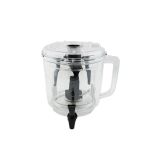You have heard advice about soaking, sprouting or roasting nuts, seeds, legumes, grains primarily to remove the phytic acid in them which inhibits mineral absorption and to better digest these foods. Over the decades, phytic acid has been badly maligned as an “anti-nutrient”, but is it possible that this has been blown out of proportion a bit? Have you heard that phytic acid also has many positive effects on health? Let’s take a closer look.


What most people don’t know is that phytic acid is concentrated mostly in the outer hull/bran of the plant seed. Therefore, if you remove the outer hull/bran, you will remove the phytic acid as well. This is why the milks prepared with The NutraMilk contain very small amounts of phytic acid or none at all. When using the NutraMilk, the nuts are processed in to a smooth butter, resulting in very fine particles. When these particles are mixed & emulsified with water, the solution goes through a fine 100 mesh system that filters out larger particles – leaving the outer hull behind and resulting in a very finely filtered, smooth nut milk. However, this is not the case for nut butters as the whole raw ingredient is used including the outer hull/bran of the nut.
Dietary phytate, or phytic acid, has been known to impair absorption of iron, zinc, and calcium as well as magnesium and copper. This only affects the meal or food with which the phytic acid was consumed — not other meals or foods throughout the day. This occurs because phytates naturally bind with these minerals as they go through the body undigested. However, grains, legumes, nuts and seeds are not a primary source of these minerals anyway, so as long as you are consuming enough of these minerals or pairing them with certain foods, their absorption may not be as affected by the phytates.
Since phytic acid is a naturally occurring substance found only in certain plant foods, calcium absorption from dairy products is not affected. Meat and seafood are good sources of bioavailable iron and zinc. For vegans, iron and calcium are found in vegetables like kale, broccoli, cabbage, and bok choy, as well as fortified foods. Nuts and seeds are concentrated sources of magnesium and copper so you are likely getting enough of these minerals if you consume them regularly.
Research also shows that having a favorable gut flora, in some cases can break down phytic acid (due to having more of the enzyme, “phytase”). The addition of fermented foods and a well balanced diet are important to help promote your gut flora.
In regards to digestion issues caused by phytic acid, some studies have hinted the possibility of certain effects, however, this is not well documented, much more research is needed to confirm. While, on the other hand, what has been well documented are the various beneficial effects on the body by this same unique substance.
Certain groups of people should be more cautious of consuming high amounts of phytic acid, including children, vegans, and people in developing countries who are at risk for mineral deficiencies. With some careful planning and learning to eat a well-balanced diet, phytic acid should not be a problem.
MAXIMIZING MINERAL ABSORPTION & MINIMIZING NEGATIVE EFFECTS OF PHYTIC ACID
If you want to maximize the absorption of these minerals when consuming a diet rich in phytic acid, you can pair these foods with mineral enhancers which will reduce or balance out the potential mineral losses.


If you want to maximize the absorption of these minerals when consuming a diet rich in phytic acid, you can pair these foods with mineral enhancers which will reduce or balance out the potential mineral losses.
Foods that act as mineral enhancers include:
- The allium family of veggies which includes garlic and onions. For example, brown rice cooked with 1-2 cloves of garlic or eaten with 1-2 thin slices of onion was shown to increase the availability of iron and zinc by up to 50% more.
- Vitamin C rich foods: citrus fruits, bell pepper, broccoli, papaya, strawberries, etc.
Vitamin A and beta-carotene rich foods: sweet potatoes, carrots, dark leafy greens, squash, pumpkin, etc. - Calcium rich foods: dairy (milk, yogurt, cheese, kefir), kale, broccoli, cabbage, bok choy, and fortified foods.
- Higher protein (from animal or plant sources), and/or Vitamin D-containing foods (oily fish like tuna or salmon, food products fortified with Vitamin D, cheese, and egg yolks)
Other factors that can have an effect:
- Eating a well balance diet - Including fermented foods to promote healthy gut flora
- Soaking, sprouting or roasting are always an option as well, but not always necessary. Remember that phytic acid has important health benefits.
- The beauty of the NutraMilk is its simplicity of making nut milk in minutes. If you are still concerned, of course you can choose to soak. But for those days that you are on a rush or forget – you can make nut milk easily and quickly without that extra step.
POSITIVE HEALTH EFFECTS OF PHYTIC ACID
Despite a few potential issues, phytates are actually good for us. Research shows that phytic acid targets cancer through several pathways such as antioxidant, anti-inflammatory, and immune-enhancing activities. It has also shown to have positive effects on diabetes, heart-disease, and kidney stone prevention as well as helping in the removal of toxic metals from the body. Please see references below if you are interested for more details on some of these studies.
The truth is that mineral deficiencies caused by too much phytic acid in the diet are mostly a concern in developing countries where diets tend to be nutritionally deficient or borderline. In the context of a well-balanced diet, rich in calcium, vitamin D, vitamin A, vitamin C, and good fats, the phytic acid in nuts, seeds, beans and grains is unlikely to cause any mineral deficiency and the potential benefits probably outweigh the potential negative effects.
So, one more reason to eat a clean, healthy, whole and well-balanced diet!
REFERENCES:
R. Greiner, U. Konietzny, K. D. Jany. Phytate – an undesirable constituent of plant-based foods? Journal fur Ernahrungsmedizin 2006 8(3):18 – 28.
A. M. Shamsuddin. Anti-cancer function of phytic acid. Int J Food Sci Tech 2002 37(7):769 – 782.
I. Vucenik, A. M. Shamsuddin. Protection against cancer by dietary IP6 and inositol. Nutr Cancer 2006 55(2):109 – 125.
G. L. Deliliers, F. Servida, N. S. Fracchiolla, C. Ricci, C. Borsotti, G. Colombo, D. Soligo. Effect of inositol hexaphosphate (IP6) on human normal and leukaemic haematopoietic cells. British journal of haematology 2002 117(3):577 – 587.
E. Graf, J. W. Eaton. Dietary suppression of colonic cancer fiber or phytate? Cancer 1985 56(4):717 – 718.
I. Vucenik, A. Passaniti, M. I. Vitolo, K. Tantivejkul, P. Eggleton, A. M. Shamsuddin. Anti-angiogenic activity of inositol hexaphosphate (IP6). Carcinogenesis 2004 25(11):2115 – 2123.
A. M. Shamsuddin. Anti-cancer function of phytic acid. Int J Food Sci Tech 2002 37(7):769 – 782.
U. Schlemmer, W. Frolich, R. M. Prieto, F. Grases. Phytate in foods and significance for humans: Food sources, intake, processing, bioavailability, protective role and analysis. Mol Nutr Food Res 2009 53 – Suppl – 2:S330 – 75.
B. Harland, E. Morris. Phytate: a good or a bad food component? Nutr Res 1995 15(5):733-754.
M. del Mar Arriero, J. M. Ramis, J. Perelló, M. Monjo. Inositol hexakisphosphate inhibits osteoclastogenesis on RAW 264.7 Cells and human primary osteoclasts. PLoS ONE 2012 7(8):e43187.











